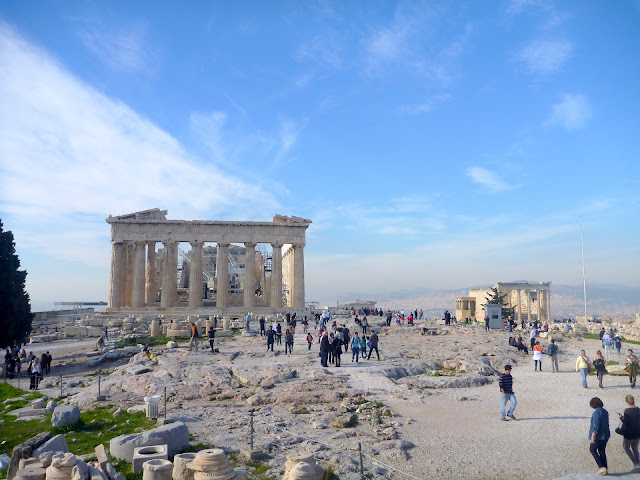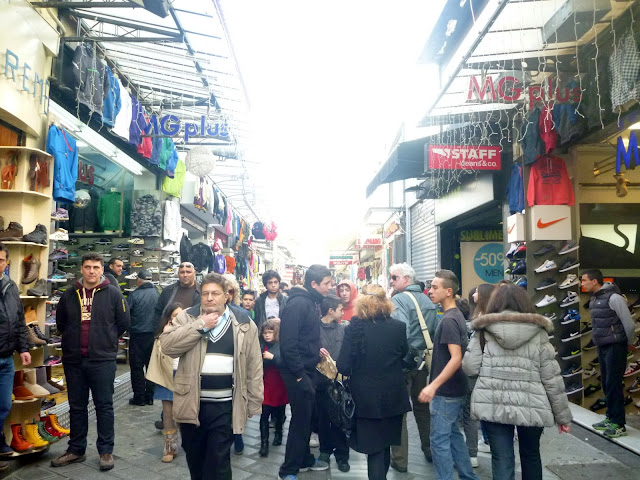We pretended we were tourists last week when friends were visiting and we showed them around.
We started outside the Acropolis Metro station which is by the Acropolis Museum, and this is the back of the modernist building.
another view of the side of the building. I could not take any photographs of the front as I was facing the sun which was very strong that day
A view of the Acropolis from the Irodou Attikou Avenue. Hardly any scaffolding from this side, phew!
One of the few remaining Art Nouveau buildings in Athens. The authorities wanted to demolish it so that there would be a straight view of the Acropolis from the Museum - typical shortsightedness of the Greek government, but there was too much opposition to the plan, so it was shelved
the entrance to the building - the graffitti is sheer vandalism.
We continued walking up the Avenue until we got to the Irodou Attikou Roman theatre, which is where we saw the performance of Mikis Theodorakis' Canto General last summer
and this is what the theatre looks like as seen from the Acropolis.
Limited visibility due to the smog created by the wood and other materials that people are burning in order to keep warm
A good view of the Iphaistion, also called Thesion, which is in the middle of the Ancient Agora and is one of the most well preserved temples - it was dedicated to Iphaistos, the god of fire.
About to enter the Propylae which is the entrance to the Acropolis on the west side. This building was the work of the architect Mnesikles and was erected in 437-432 BC. It consists of a central building and two wings. The north wing had frescos on its walls and is therefore known as the Pinakotheke.
The Erechtheion, built between 421 and 406 BC and the architect may have been Mnesikles. The sculptor and mason was Phidias. On the north side there is a porch with six Ionic columns while on the south is the 'Porch of the Maidens' with six draped female figures, the Karyates acting as supporting figures. The temple was dedidated to Athena and Poseidon. Within the foundations lived the sacred snake of the temple which represented the spirit of Cecrops and whose well-being was thought essential for the safety of the city. It was fed honey cakes by the priestesses of Athena. The snake's occasional refusal to eat the cakes was thought a disastrous omen.
In 1801 one of the Karyates was removed by Lord Elgin in order to decorate his Scottish mansion and later sold to the British Museum along with the pedimental and frieze sculpture taken from the Parthenon. Athenian legend had it that at night the remaining five Karyates could be heard wailing for their lost sister. Elgin attempted to remove a second Karyate; when technical difficulties arose he tried to have it sawn to pieces. The statue was smashed and its fragments were left behind. It was later reconstructed haphazardly with cement and iron rods. In 1979 the original five Karyates were removed to the Acropolis Museum and replaced in situ by exact replicas.
Lycabettus Hill in the distance
zooming in
The remains of the Temple of Olympian Zeus in the distance. A colossal ruined temple, its construction began in the 6th century BC, it was meant to be the biggest temple in the ancient world, but it was not completed until the 2nd century AD during the reign of Roman emperor Hadrian. During the Roman period it was renowned as the largest temple in Greece and housed one of the largest cult statues of the ancient world. The temple fell into disuse after being pillaged in a barbarian invasion in the 3rd century AD.
The Parthenon dedicated to Athena whom the people of Athens considered their patron. Its construction began in 447 BC and was completed in 438 BC. It is the most important building of classical Greece, generally considered the culmination of the Doric order. In 1806 Lord Elgin removed some of the sculptures with Ottoman permission. These sculptures, now known as the Elgin Marbles were later sold to the British Museum.
One more photograph of the Parthenon that I have downloaded from the internet - there is so much scaffolding at the moment that I could not take a further satisfactory photograph
Moving along around the Parthenon on the south slope of the Acropolis we can see the Theatre of Dionysus below as well as the Acropolis Museum in the distance.
We then walked down the hill and came to the Roman Forum, located near the Ancient Agora. The Ancient Agora, in the centre of the ancient city, is a large open area surrounded by buildings of various functions. It was utilised for commerce, political, religious and military activity. Meetings were held four times a month to enact legislation, to hear embassies, and deal with defence. The Winds Monument is on the right. This is an octagonal monument built with Pendelic marble featuring a combination of sundials, a water clock and wind vane. Below the frieze featuring the eight wind deities there are eight sundials.
We then walked through the flea market
and on to Adrianou Street which is full of restaurants, cafes and bars. It was a sunny day so everyone was sitting outside.
We chose Kuzina as the place to have lunch
but, like everyone else, we sat outside where we could have a distant view of the Acropolis
zooming in
one more view of the Acropolis from Monastiraki Square seen as we were heading home.
























I envy you. I haven't yet made it to Greece let alone Athens so your post made great reading for me!
ReplyDeleteThank you for your comment and I am glad you enjoyed the post. I hope you make it to Greece some time soon. I had a look at your blog, enjoyed reading it and will do so on a regular basis from now on - it is always great meeting fellow bloggers who have similar interests.
Delete